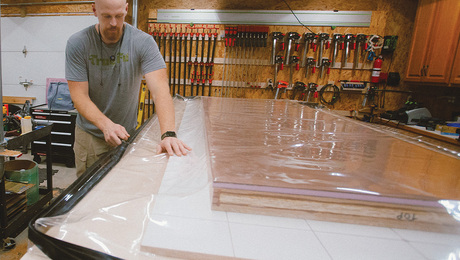Hello all…
I’ve replaced a few toilets, and done a good amount of general plumbing but for the first time I need to plumb and install a toilet. Any particular tips or pitfalls anyone can offer?. Am I right in recalling that the closet flange sits flush (so to speak) with the finished floor? Tried looking through my books for a toilet installation for dummies, but no luck… Thanks!
Paul




















Replies
Ideally the bottom of the flange should sit on the finished floor. Since the flange is about 1/4" thick, this makes the top of the flange 1/4" proud of the floor.
In practice, having the top of the flange anywhere from flush to about 3/8" proud is OK, though it depends somewhat on the particular stool. Better too low than too high, since you can always use an extra-thick wax ring (or two rings), but if the flange is too high the wax gets smashed flat (causing leaks) and even then the stool may not sit flat on the floor.
Keep in mind that measurements of the flange height should be relative to the place where the edge of the stool will rest, not the floor immediately adjacent to the flange. Often on a concrete floor or mud tile job the floor will bulge slightly around the drain pipe, and this can upset measurements.
If at all possible, get a flange with metal reenforcement in the actual flange portion, vs one of those that's all plastic. The all-plastic units break far too easily.
Thanks for that Dan. I'm in the midst of trying to give myself a crash course on toilet installation, I plan on roughing all the plumbing in this room in tomorrow.
Did a toilet job some time ago. Had everything ready to go together with he stainless anchor bolts in place ready to drop the toilet down onto the wax ring. Problem was that by the time I got the toilet into position the bolts had fallen over so I would have to put the unit down and reposition the bolts.
Got a sore back doing this a couple of times before I got me some plumbers putty, I think duct seal or any other neutral and non-hardening putty would work at well, and packed this around the bolts to hold them in position.
Once I did this the toilet mated up beautifully and the bolt down went swimmingly. If the kit doesn't have them get a some of the rubber fender washers to make sure the steel washers don't contact the porcelain. Tighten the bolts snug but not too tight. Fastest way to work the bolts is a deep well socket and wrench but because these units give you so much leverage be careful. Backing the nut off half a turn after the porcelain cracks won't do you much good.
Get one of those hacksaw blade handles, about $5 to $10, because they work very well in the tight spots around a toilet base. With a fine tooth blade installed you can shorten the mounting bolts so they fit under the porcelain caps that keeps everything looking neat. These units also come in handy cutting metal in tight spots. A Dremel, in pinch a drill, with a small, about an inch-and-a-quarter, cut-off blade also works well.
Also get a shim kit for the toilet tank, if you have a separate tank, to keep it from wobbling. You may not need it but having it on hand, a couple of dollars, might save a trip.
For mounting bolt you may see three types, regular steel, brass and stainless. The steel ones, I think they are galvanized, are a pain as the nuts rust in place when exposed to chemicals used for cleaning. A royal PITA. Brass is better but these can still corrode gall and seize. Get the stainless. Much less trouble if you have to mess with them later.
Yeah, but the brass is much easier to cut off!
and have some easily cuttable rubber shims instead of hard plastic shims for placing between the finish floor and the stool, in the event you find an uneven floor that can cause the stool to rock."sobriety is the root cause of dementia.", rez,2004
"Geodesics have an infinite proliferation of possible branches, at the whim of subatomic indeterminism.",Jack Williamson, The Legion of Time
Another hint for when you're working in a tight spot, trying to get the toilet set over the bolts and trying to get the wax ring set right. Get a couple of short 2x4s and set them up on edge, one in front of the flange and one behind. Set the toilet down on this, then position it over the bolts and check the wax ring position.. Then lift first one end then the other of the bowl and flip the 2x4s flat. Double-check bolt position, then pull out the 2x4s.
Great tips guys, thank you all :) Now I'm reading about the plumbing ... done quite a bit of plumbing but never a toilet. How hard can it be? (Excuse me? The toilet's flushing into the shower?"... "wrong number")
where do you put the wax ring for installation
on the toilet
or on the flange?
When I've replaced toilets I've put it on the flange but everything I've read says to put it on the toilet. Not sure why that is, I've always worried about it falling off enroute to the flange...
Although a bit more expesive, I started using the waxless ring by fluid master. Love not having that mess, particularly if the bolts fall over, or some other unexpected problem....haven't had any problems to date, and can't wait till I have to one day pull a toilet up with a waxless.....don't have to search for my "TOILET WAX ONLY" scraper. (that wax just makes me quesey) BeckRe-Home Solutions Inc.
the fluidmaster seems to seal to the plumbing by O rings
how does it seal to the toilet?
When I've replaced toilets I've put it on the flange but everything I've read says to put it on the toilet. Not sure why that is, I've always worried about it falling off enroute to the flange...
I think this is done because the flange is flat and the toilet has a convenient circular ridge in which to place the wax ring over/around. Although I thought about it, I can't imagine putting the wax ring on the flange first and then hoping the circular ridge of the toilet fits precisely in the wax ring already mounted on the flange.
Certainly if the weather is a bit warmer, the wax ring tends to "stick" better to the porcelain of the toilet, but pressing the wax ring into the same should do the trick and not allow the ring to fall off the toilet when raised and lowered to the flange. Usually you can see the wax creeping out of the bolt holes, where this may assure you of its stability as you're lowering the thing on the flange.
I've found that with 2 added 1/4-20 nuts , you can put a nut on the bolt and spin it down to the flange, then set the crapper and nut it down..no more wobbly bolts.
I also like the pre-scored easy to snap off bolts
Spheramid Enterprises Architectural Woodworks
Repairs, Remodeling, Restorations.
Lots of the bolt sets come with plastic washers that have fingers inside the hole so they work kind of like push nuts. Holds the bolt in place with minimal added thickness. I've also used real live push nuts for this duty, since they're nice and thin. (Yeah, they'll rust, but who cares after the toilet's seated?)
Adding regular nuts on top may work, but may add too much thickness in some cases.